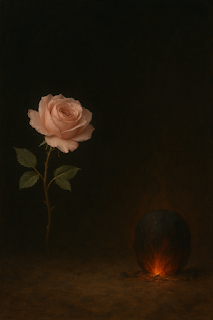George Herbert’s Virtue is a quiet yet powerful devotional poem that explores the contrast between the fleeting beauty of the natural world and the eternal nature of a virtuous soul. As a 17th-century metaphysical poet and priest, Herbert blends spiritual reflection with lyrical grace, offering a poem that’s rich in imagery and moral depth. Though short in form, Virtue speaks volumes about life, death, and the enduring value of goodness. In a time when outward appearances are often celebrated, Herbert reminds us that it is inner purity and moral strength that truly last.
Analysis
George Herbert’s Virtue gently walks us through the contrast between fleeting beauty and everlasting goodness. The poem opens with a vision of a perfect day:
The sweet day, so cool, so calm, so bright,
The bridal of the earth and sky:
The dew shall weep thy fall to-night;
For thou must die.
The day is described in harmonious, wedding-like imagery — a union of heaven and earth. But the dew “weeps” by nightfall, and Herbert ends the stanza with the grim reminder of death. This pattern repeats, as he turns next to the rose:
The sweet rose, whose angry and brave root
Gave life to that vermeil hue;
Bites the grace and virtue out of the root:
For thou must die.
Even the vibrant rose, full of life and fire, must perish. Its redness (“vermeil hue”) comes from a strong root, but the beauty cannot escape time’s touch. The third stanza expands the image to the larger cycle of life:
Sweet spring, full of sweet days and roses,
A box where sweets compacted lie;
My music shows ye have your closes,
And all must die.
Spring, the season of renewal, is pictured as a treasure chest of pleasures. But even music, which often represents harmony and joy, has its “closes” — its endings. The mood turns gently melancholic. Just as a song must end, so must life’s sweetest seasons.
Only a sweet and virtuous soul,
Like season’d timber, never gives;
But though the whole world turn to coal,
Then chiefly lives.
Here lies the heart of the poem. Unlike all the lovely yet dying things before, the virtuous soul is strong like seasoned wood — resilient, lasting, glowing. Even when the world collapses into darkness, virtue doesn’t just survive; it thrives. It lives more truly when everything else fades.
Through this structure, Herbert teaches that while nature’s beauty fades, virtue is timeless. It's a quiet but enduring fire — not loud, not showy, but eternal. His message is simple yet profound: what glows within us lasts longer than what shines outside us.
Conclusion
George Herbert’s Virtue is not just a religious poem; it is a universal meditation on mortality and moral endurance. In every image of passing beauty, we are invited to reflect on what truly matters. While flowers wither and days end, a virtuous life carries an eternal flame. In today’s fast-changing, image-driven world, Herbert’s message is more relevant than ever — that quiet goodness, like seasoned wood, burns deep and lasts long.



No comments:
Post a Comment